Abstract
1. Chronic administration of ethanol, morphine, nicotine or phenobarbitone has previously been shown to enhance rat brain 5-hydroxytryptamine (5-HT) synthesis by increasing the availability of circulating tryptophan to the brain secondarily to the NADPH-mediated inhibition of liver tryptophan pyrrolase activity. 2. Naloxone reverses the above enhancement of 5-HT synthesis and the accompanying increase in tryptophan availability to the brain and the inhibition of liver tryptophan pyrrolase activity. 3. It is suggested that naloxone exerts these effects by antagonizing the chronic drug-induced increase in liver [NADPH]. 4. Naloxone increases serum corticosterone concentration in rats chronically treated with the above four drugs of dependence. Possible explanations of this effect are discussed.
Full text
PDF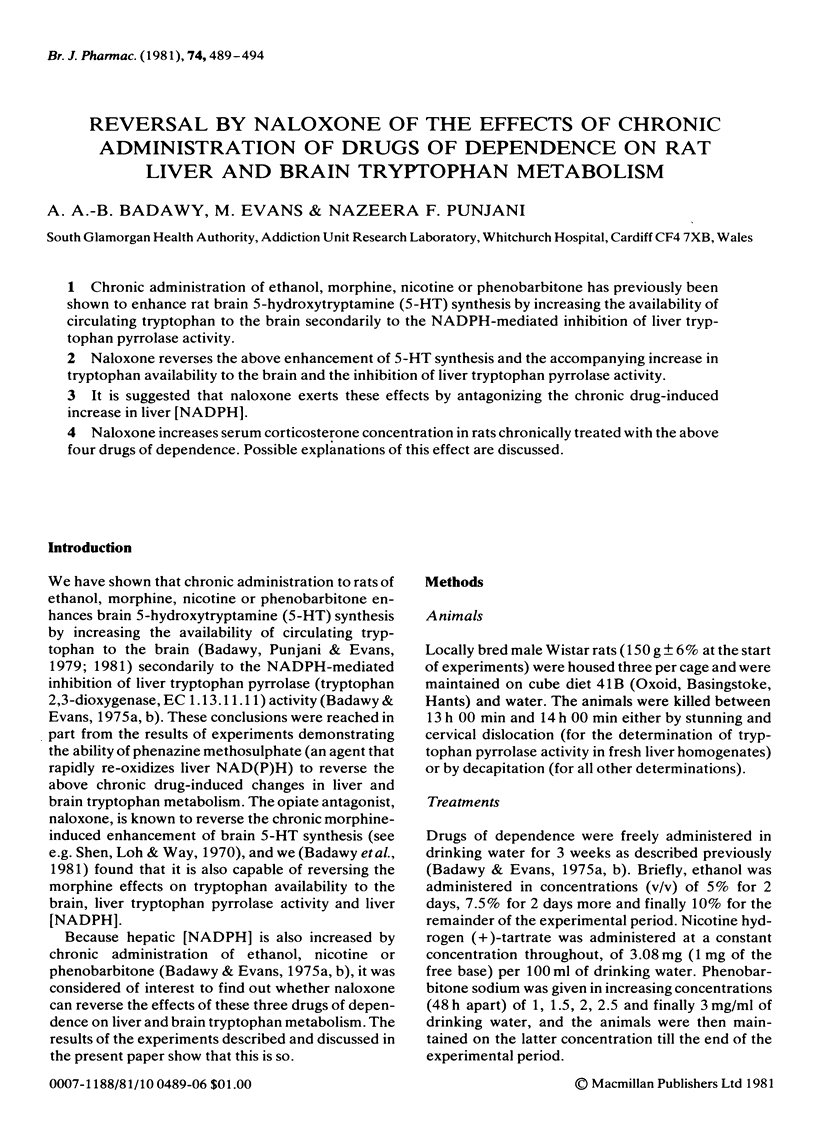
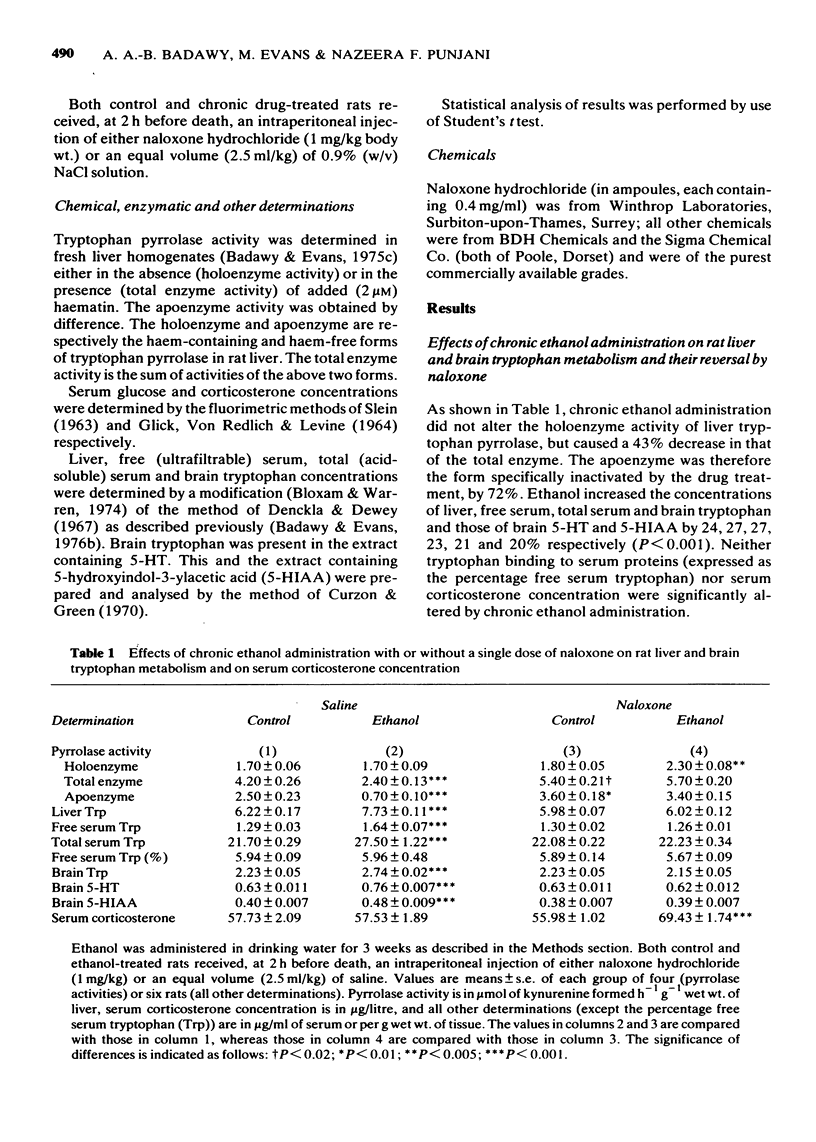
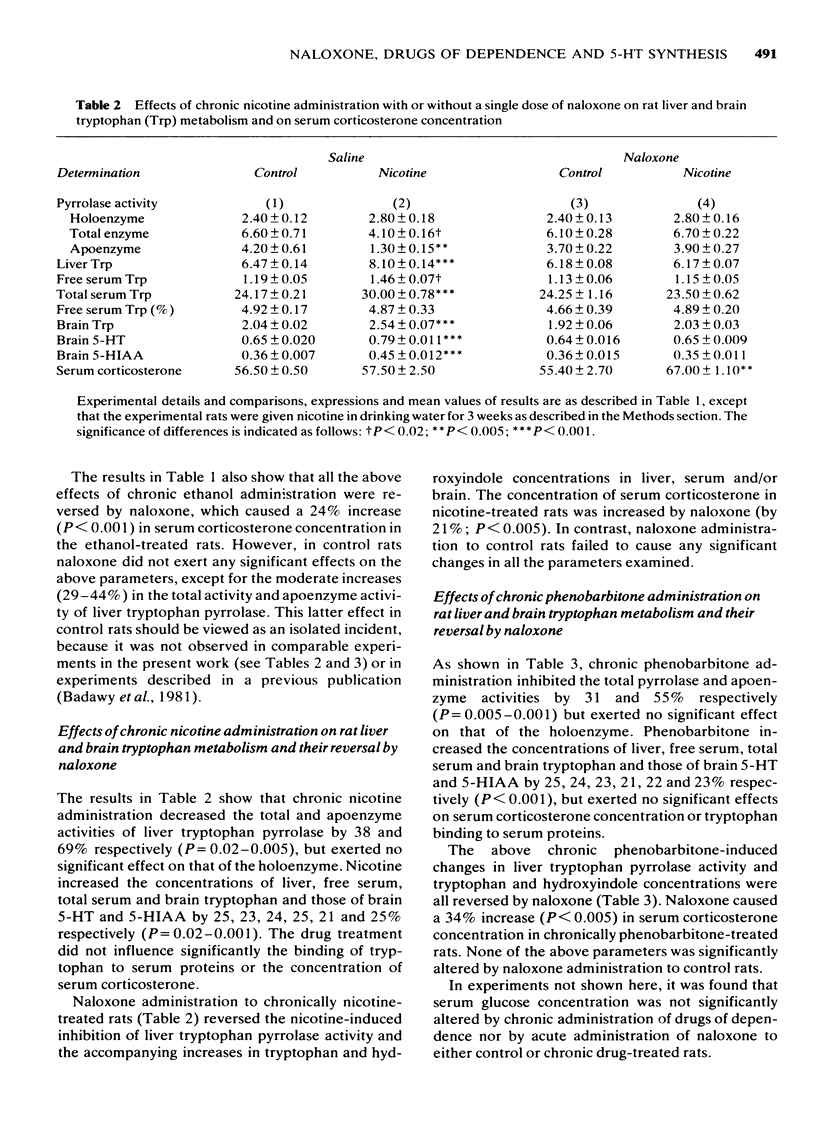
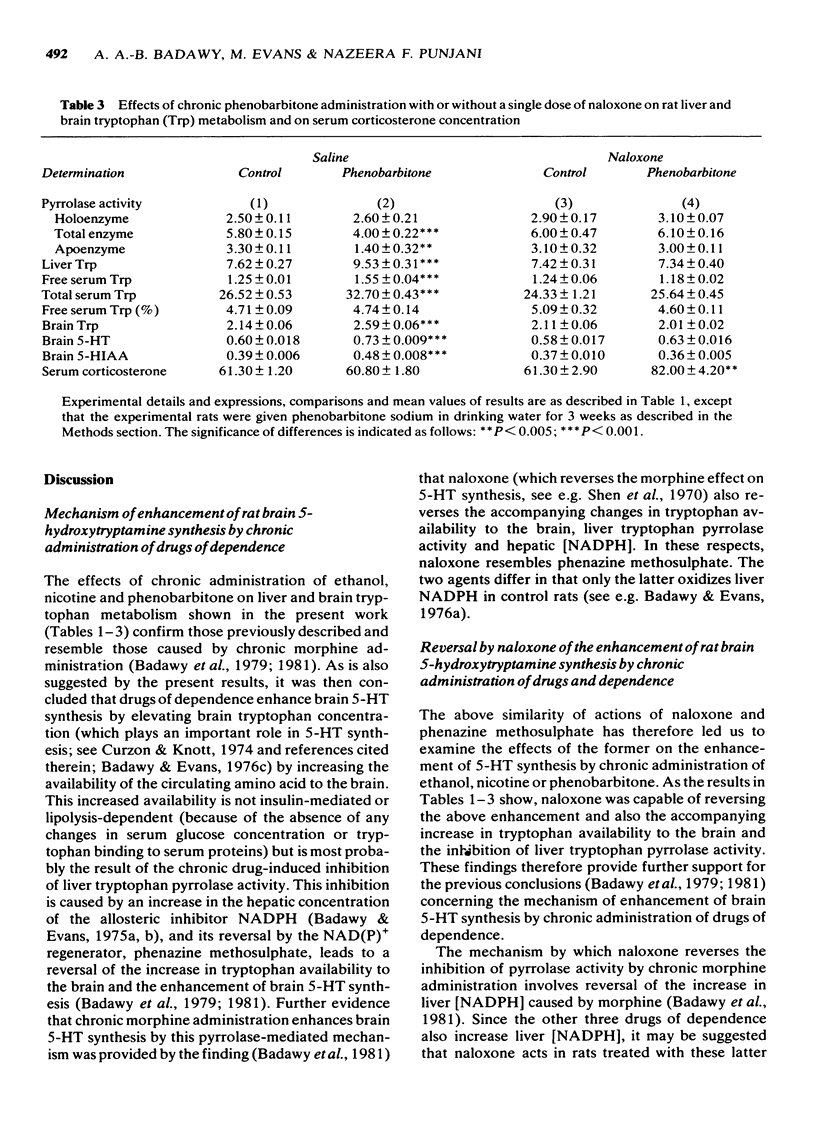
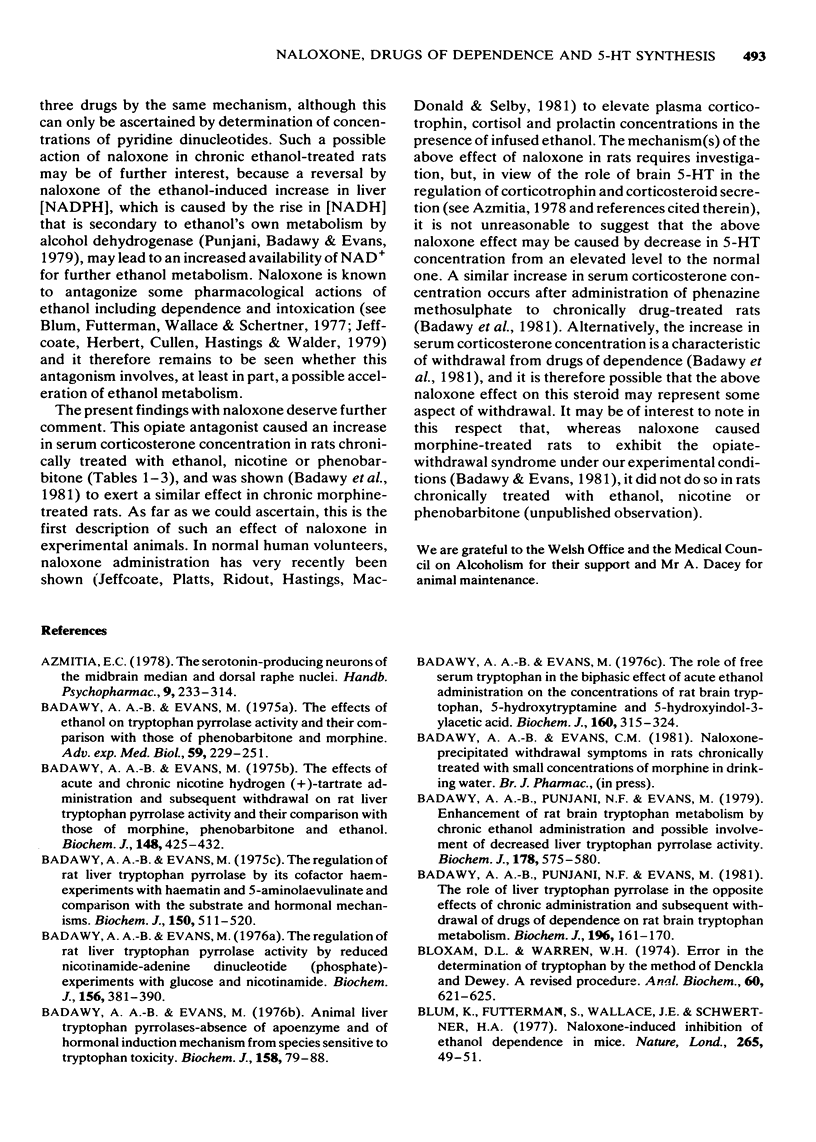
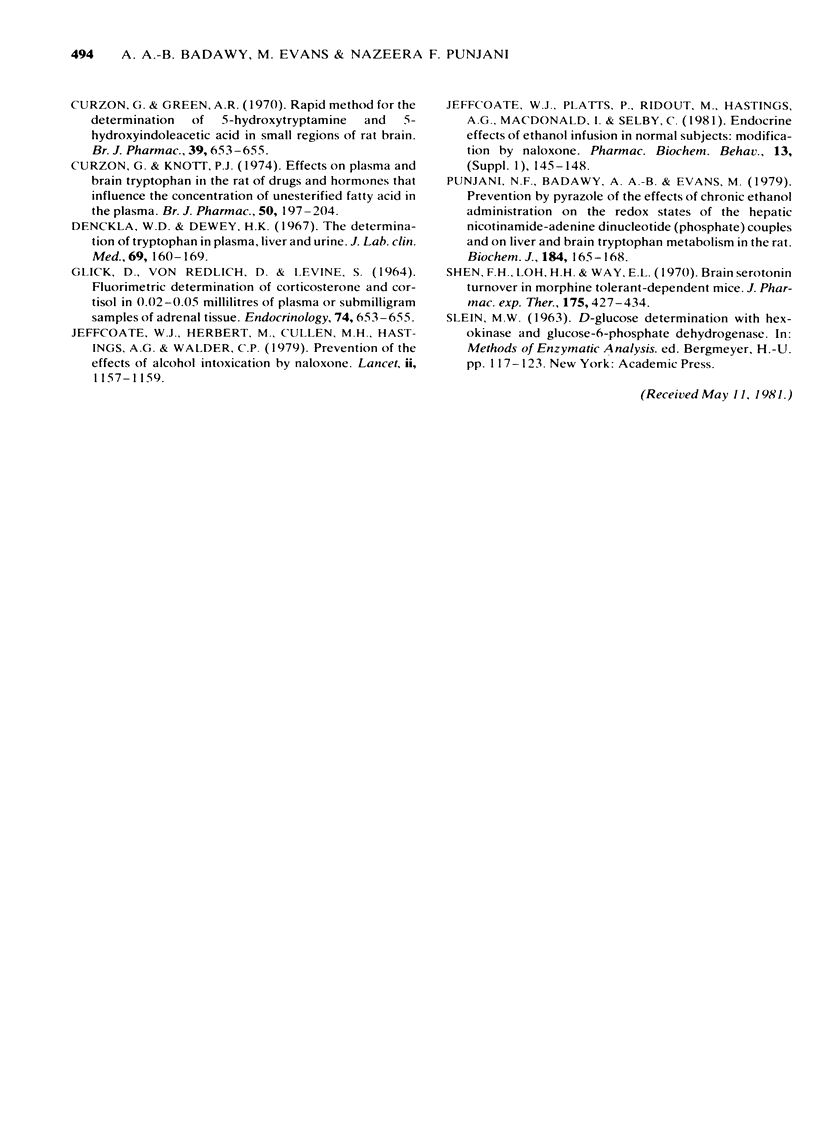
Selected References
These references are in PubMed. This may not be the complete list of references from this article.
- Badawy A. A., Evans M. Animal liver tryptophan pyrrolases: Absence of apoenzyme and of hormonal induction mechanism from species sensitive to tryptophan toxicity. Biochem J. 1976 Jul 15;158(1):79–88. doi: 10.1042/bj1580079. [DOI] [PMC free article] [PubMed] [Google Scholar]
- Badawy A. A., Evans M. Regulation of rat liver tryptophan pyrrolase by its cofactor haem: Experiments with haematin and 5-aminolaevulinate and comparison with the substrate and hormonal mechanisms. Biochem J. 1975 Sep;150(3):511–520. doi: 10.1042/bj1500511. [DOI] [PMC free article] [PubMed] [Google Scholar]
- Badawy A. A., Evans M. The effects of acute and chronic nicotine hydrogen (+)-tartrate administration and subsequent withdrawal on rat liver tryptophan pyrrolase activity and their comparison with those of morphine, phenobarbitone and ethanol. Biochem J. 1975 Jun;148(3):425–432. doi: 10.1042/bj1480425. [DOI] [PMC free article] [PubMed] [Google Scholar]
- Badawy A. A., Evans M. The effects of ethanol on tryptophan pyrrolase activity and their comparison with those of phenobarbitone and morphine. Adv Exp Med Biol. 1975;59:229–251. doi: 10.1007/978-1-4757-0632-1_15. [DOI] [PubMed] [Google Scholar]
- Badawy A. A., Evans M. The regulation of rat liver tryptophan pyrrolase activity by reduced nicotinamide-adenine dinucleotide (phosphate). Experiments with glucose and nicotinamide. Biochem J. 1976 May 15;156(2):381–390. doi: 10.1042/bj1560381. [DOI] [PMC free article] [PubMed] [Google Scholar]
- Badawy A. A., Evans M. The role of free serum tryptophan in the biphasic effect of acute ethanol administration on the concentrations of rat brain tryptophan, 5-hydroxytryptamine and 5-hydroxyindol-3-ylacetic acid. Biochem J. 1976 Nov 15;160(2):315–324. doi: 10.1042/bj1600315. [DOI] [PMC free article] [PubMed] [Google Scholar]
- Badawy A. A., Punjani N. F., Evans M. Enhancement of rat brain tryptophan metabolism by chronic ethanol administration and possible involvement of decreased liver tryptophan pyrrolase activity. Biochem J. 1979 Mar 15;178(3):575–580. doi: 10.1042/bj1780575. [DOI] [PMC free article] [PubMed] [Google Scholar]
- Badawy A. A., Punjani N. F., Evans M. The role of liver tryptophan pyrrolase in the opposite effects of chronic administration and subsequent withdrawal of drugs of dependence on rat brain tryptophan metabolism. Biochem J. 1981 Apr 15;196(1):161–170. doi: 10.1042/bj1960161. [DOI] [PMC free article] [PubMed] [Google Scholar]
- Bloxam D. L., Warren W. H. Error in the determination of tryptophan by the method of Denkla and Dewey. A revised procedure. Anal Biochem. 1974 Aug;60(2):621–625. doi: 10.1016/0003-2697(74)90275-9. [DOI] [PubMed] [Google Scholar]
- Blum K., Futterman S., Wallace J. E., Schwertner H. A. Naloxone-induced inhibition of ethanol dependence in mice. Nature. 1977 Jan 6;265(5589):49–51. doi: 10.1038/265049a0. [DOI] [PubMed] [Google Scholar]
- Curzon G., Knott P. J. Effects on plasma and brain tryptophan in the rat of drugs and hormones that influence the concentration of unesterified fatty acid in the plasma. Br J Pharmacol. 1974 Feb;50(2):197–204. doi: 10.1111/j.1476-5381.1974.tb08562.x. [DOI] [PMC free article] [PubMed] [Google Scholar]
- Denckla W. D., Dewey H. K. The determination of tryptophan in plasma, liver, and urine. J Lab Clin Med. 1967 Jan;69(1):160–169. [PubMed] [Google Scholar]
- GLICK D., VONREDLICH D., LEVINE S. FLUOROMETRIC DETERMINATION OF CORTICOSTERONE AND CORTISOL IN 0.02-0.05 MILLILITERS OF PLASMA OR SUBMILLIGRAM SAMPLES OF ADRENAL TISSUE. Endocrinology. 1964 Apr;74:653–655. doi: 10.1210/endo-74-4-653. [DOI] [PubMed] [Google Scholar]
- Jeffcoate W. J., Herbert M., Cullen M. H., Hastings A. G., Walder C. P. Prevention of effects of alcohol intoxication by naloxone. Lancet. 1979 Dec 1;2(8153):1157–1159. doi: 10.1016/s0140-6736(79)92385-7. [DOI] [PubMed] [Google Scholar]
- Jeffcoate W. J., Platts P., Ridout M., Hastings A. G., MacDonald I., Selby C. Endocrine effects of ethanol infusion in normal subjects: modification by naloxone. Pharmacol Biochem Behav. 1980;13 (Suppl 1):145–148. doi: 10.1016/s0091-3057(80)80023-2. [DOI] [PubMed] [Google Scholar]
- Punjani N. F., Badawy A. A., Evans M. Prevention by pyrazole of the effects of chronic ethanol administration on the redox states of the hepatic nicotinamide--adenine dinucleotide (phosphate) couples and on liver and brain tryptophan metabolism in the rat. Biochem J. 1979 Oct 15;184(1):165–168. doi: 10.1042/bj1840165. [DOI] [PMC free article] [PubMed] [Google Scholar]
- Shen F. H., Loh H. H., Way E. L. Brain serotonin turnover in morphine tolerant and dependent mice. J Pharmacol Exp Ther. 1970 Nov;175(2):427–434. [PubMed] [Google Scholar]


